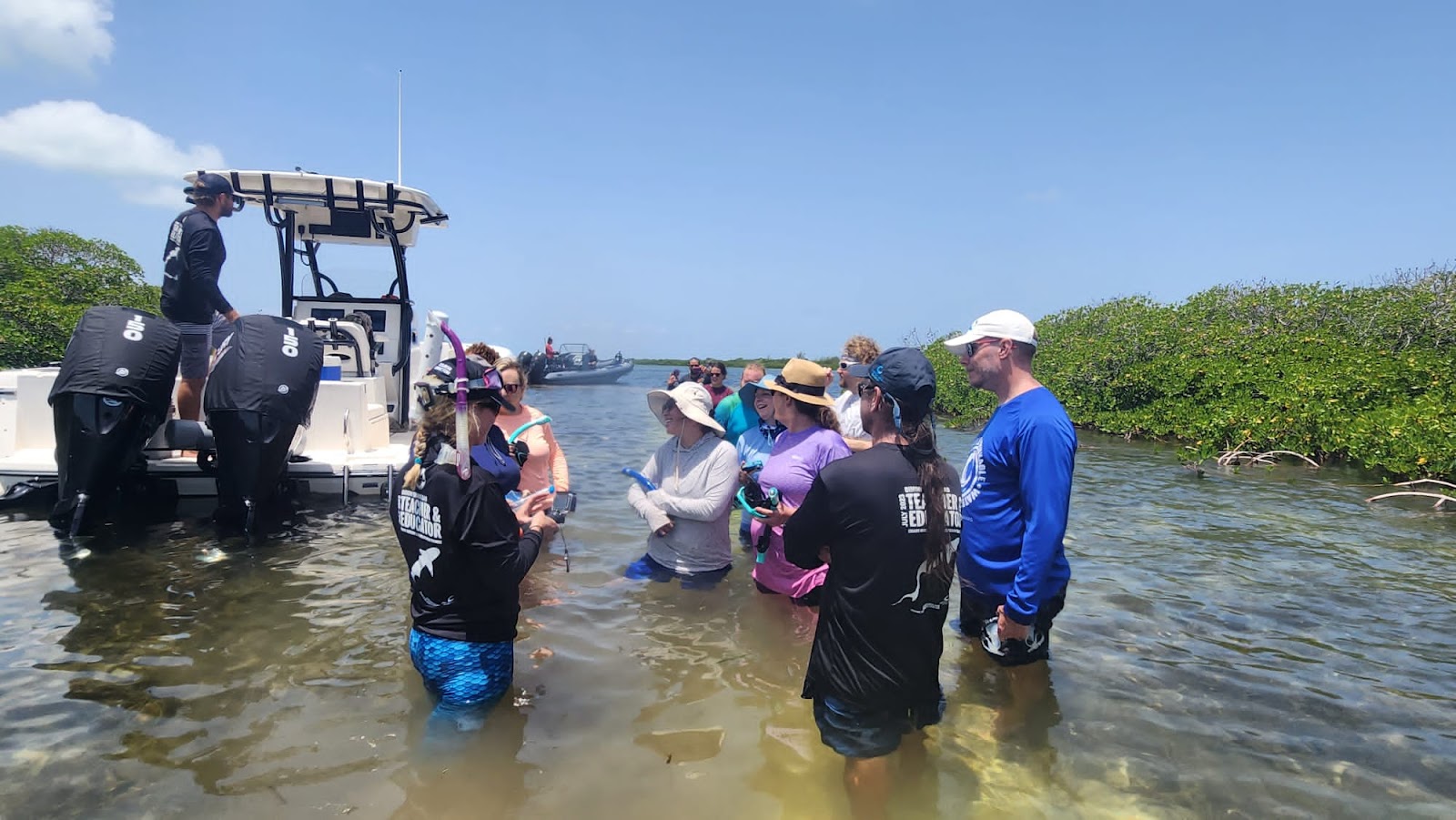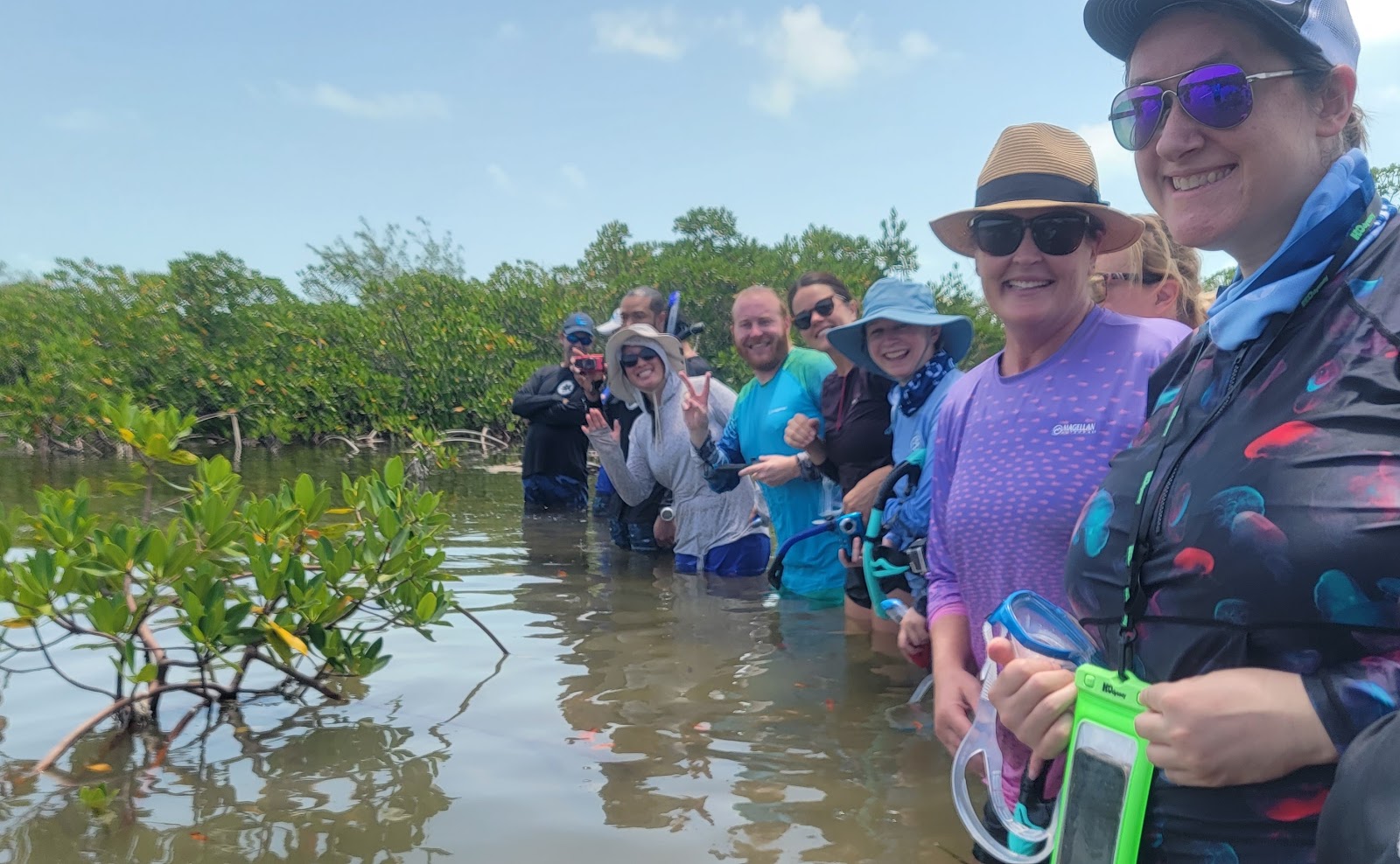 |
| Smile for the camera! |
It was a looooooooong travel day, getting up at 4:30 in the morning in Saipan to make my flight to Tokyo.
Luckily I was flying with my roommate and new friend Erin, so the 7 ½ hour layover wasn’t too bad. We then flew to San Francisco (where the layover was long enough that I went home to shower and restock my bag), then a redeye to Fort Lauderdale where I met up with teachers Vickie and Sarah. The rest of the 15-teacher cohort met at the airport for our 25 minute charter flight to South Bimini – our little float plane flew over the lagoon by North Bimini, and we could see schools of eagle rays and several sharks swimming in the clear, shallow waters!!South Bimini is a tiny, low-lying island about 50 miles east of Miami, Florida. It has one paved road, one gas station, and about 150 residents. It’s only about 500 feet from the much more bustling North Bimini (population around 2,500) - but there are no roads connecting the two.
 |
| Pineapple House! |
 |
| Easing our way into shark infested waters... |
Baylie and Felicie, researchers at the lab, were throwing fish into the water in hopes of attracting sharks, and we waded thigh-deep in and waited. Most of the bait was being stolen by sea birds, who were scaring off the baby sharks, but we finally did see two small lemon sharks who were learning how to hunt and pinpoint prey. They were skittish and didn’t come too close, but it was an exciting introduction to our week!
 |
| The famed Lab Table |
 |
| Pineapple House at the field station: Carly, Vickie,Sean, me, Jules, Jackie, Mattias, Dylan, and Emily |
There are 1,241 species of Chondricthyans, the class of vertebrates that include chimeras, sharks, and rays that have skeletons made of cartilage. The subclass Elasmobranchs have 5 to 7 gill slits, and sharks and rays are divided based on whether their pectoral (side) fins are fused to their heads. We went through nearly every family of shark and ray, and the main takeaway was that most sharks are small - only a few feet long, and definitely not man-eating predators that most people imagine when hearing the word 'shark'.
They are also maligned, threatened, and vilified in the media, so we need to be doing a lot more to protect and conserve them (and all marine species)!
 |
| Lots of great lectures by Matt and Dean |
 |
| Yep, that's the whole store. |
SUNDAY, JULY 23
One of the reasons why the Shark Lab is situated on South Bimini is because of the various diverse habitats found around this tiny island.
 |
| Can't have enough mosquito repellant for a mangrove hike! |
We waded through waist- to neck-high water through the mangroves until we reached a protected lagoon that was the perfect location for a lemon shark nursery.
Also in the water were jellyfish, small needle-nosed fish, and pufferfish. The roots of the mangrove are teeming with life, and we snorkeled around the edge of the grove to get a closer look at what was living there. Nestled in the roots were bright orange sponges, and we saw baby barracudas, snails, and so many different fish. In one pit below a root ball, a huge stingray rested in the mangrove roots, and we found several others gliding across the sea grass or half-buried in the sand. There was the biggest sea star I’ve ever seen (Oreaster), as well as a gorgeous sea cucumber.
 |
| Potential chum |
Our next day’s outing was to Honeymoon Harbor near Gun Cay, just south of Bimini, where we would be baiting for stingray. The southern stingray has a flat diamond-shaped body, well adapted to stay on the ocean floor. On the top of its head are the eyes and small openings called spiracles, which take in water that flush through its gills on its belly, next to its mouth. It’s dark grey, olive, or dark brown with a white underside, and the thin tail has a serrated, venomous spine sticking back from its base. We were warned not to step back too quickly or to panic when being mobbed by rays, as they were extremely tolerant of people but would strike with their stinger if hurt or frightened.
 |
| That's me in the white hat, sparkling in the sunlight |
It was a smooth 20 minute boat ride down to the beach, and we walked into the water to stand in a line while Matt threw bait in the water to lure in the stingrays. In the lab, Dean and Matt had warned us that the rays would crowd around us – they have no sense of “personal space,” and it was so true! We started by touching the pectorals - flabby, slimy, blobs of flesh that seem too squishy and relaxed to be agents of propulsion. But when the rays swim through the water, they glide gracefully across as though soaring on wings. Soon the rays started to swim between and around our legs, sniffing for the squid juice that we were dripping into the water. Some would even ram straight into us or swim up our bodies, and even the large rays would flap around their wing-like pectoral fins to fit in spaces too small for their big floppy bodies. It was most nerve-racking when a large ray squeezed its too-large soft body in the small space between me and Jules, and the hard spine of its tail brushed against my arm.
We were given small pieces of squid to feed to the rays, but warned not to keep our fingers up as they should be fed much like a horse – with our palms flat and the squid held in place between our fingers. But we had to watch out that a hungry nurse shark didn’t come by to nip off a snack! Since the ray’s mouth is on its underside, almost under its eyes, we couldn’t see the mouth but were warned to drop the bait once we felt a light sucking motion.
 |
| They are like floppy ocean puppies! |
Soon after we dispersed, the stingrays began to drift off as well, and smaller fish started swimming in to look for missed pieces of food. Large schools of tiny silversides flowed by in wave-like ribbons, swimming in synchronized streams. A 2 ft long houndfish hovered nearby, never coming too close. It was a gorgeous, thin needle-like fish with long crocodile jaws, nearly translucent except for bright azure accents. Soon, larger snappers and permit joined the party, and we sat in the sand enjoying the encounter.
Our last day snorkeling was to the Triangle, where three very low rocks form a barrier reef that attract Caribbean reef, blacktip, and nurse sharks. Right when we entered the water there was a reef shark cruising along about 25 feet below us, but soon after a large tourist boat of snorkelers joined in, splashing and cannonballing into the water, scaring the shark away.
 |
| Ready to explore the SS Sapona |
Because of this, we soon switched locations to the Sapona shipwreck, the remnants of a World War I ship that is now an artificial reef. It’s the perfect location for many species of sponges, corals, and reef fish. We swam around and inside the shell of the wreck, as well as in the seagrass just outside. A couple green sea turtles swam by, surprisingly agile in the water and seemingly unbothered by our presence. We also saw another Southern stingray cruising along.
 |
| I'm a fan of this gorgeous sea fan |
 |
| He's molting! |
 |
| Evening tidepooling with Dean |
 |
| Can't beat me on our speedy little golf cart! |
One of the most interesting attractions on the island is the Dolphin House, a quirky home built by Bimini local Ashley Saunders, who had a connection with the ocean and particularly with dolphins and who believed in celebrating them in his decor.
 |
| Harvesting fresh conch |
On our final night, we went back to the beachside bar at the Bimini Sands for dinner and an impromptu concert from Dean. A man of many talents!! While we were there, the lab's friend Kyle stopped by with a Bimini boa that he had found. The Bimini boa is a rare, endemic species that is unfortunately now endangered because of illegal pet trade and loss of habitat. We were so excited to get to see one!
Our week at the Bimini Biological Field Station was such an amazing experience - I learned so much about sharks and rays that will hopefully help demystify them for my students. I loved getting the opportunity to interact with these extraordinary animals, and learning how to do so in a safe and sustainable way. I also loved getting the chance to see the different ecosystems around Bimini and snorkel in such warm, clear waters. I'm grateful to the Save our Seas Foundation, the Bimini Biological Field Station, and all the wonderfully dedicated staff - especially Dean, Matt, Chelle, Baylie, Felicie, Ilijah, and the rest of the team. What an unbelievable end to an incredible summer of adventure, learning, and fun. Thank you!










No comments:
Post a Comment